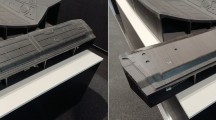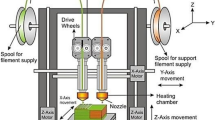Abstract
Fused filament fabrication (FFF) is an extrusion-based process that allows quick and inexpensive part production, practically without any geometric limitations, offering flexibility, promoting reduction in costs and lead-time in an industrial scenario. Being one of the most widespread additive manufacturing techniques, the process has evolved introducing new and advanced materials (e.g. high-performance polymers and composites). Despite its advantages, the process is vastly overlooked due to its high level of anisotropy, poor surface roughness and lack of geometric accuracy caused by the layer thickness. To reduce this effect, a sequence of laborious manual operations can be performed, which may result in time-consuming and inaccurate results. Therefore, efforts have been made towards the development of hybrid manufacturing technologies by combining FFF process and subtractive equipment, aiming to solve these limitations. In this work, two complementary methodologies analysing the behaviour of FFF PA12 and short fibre–reinforced PA12 printed parts when subjected to a subtractive approach are presented. The first experimental plan took into account the final surface roughness (Ra and Rz) via full factorial design of experiments (DOE) and analysis of variance (ANOVA) considering the influence of distinct printing orientations, two types of cutting tools and machining parameters such as, cutting speed, feed and cutting depth. An analysis on tool wear and SEM microscopy to the machined surface was also performed. The second approach was carried out via Taguchi and ANOVA, considering the first experimental approach results. Thus, milling parameters were the focus, evaluating the final material surface roughness, being now monitored the cutting forces and tool wear analysis in order to understand their influence on the final results. It is shown that it is possible to machine PA12-based FFF printed parts without any major problems such as layer delamination. A decrease in Ra, t of 1931% to 0.99 μ m for PA12CF and 2255% for PA12 to 0.96 μ m was achieved, proving the overall machinability of the materials. It was found that PA12 creates higher levels of cutting loads and increased tool wear, thus indicating that short fibre presence improves the material machinability, while parameters such as building orientation do not possess any influence on the final surface roughness.























Similar content being viewed by others
References
ISO/ASTM: ISO ASTM 52900:2015 - Additive manufacturing - General principles - Terminology (2015)
Williams G, Trask R, Bond I (2007) A self-healing carbon fibre reinforced polymer for aerospace applications. Compos Part A: Appl Sci Manuf 38(6):1525–1532
Chun LM, Kowalik M (2018) Preliminary studies for alternative lattice core design for FDM 3D printed sandwich panels. Mater Today: Proc 5(13):26519–26525
Mayyas A, Qattawi A, Omar M, Shan D (2012) Design for sustainability in automotive industry: a comprehensive review. Renew Sust Energy Rev 16(4):1845–1862
Ullah H, Harland AR, Silberschmidt VV (2015) Dynamic bending behaviour of woven composites for sports products: experiments and damage analysis. Mater Des 88:149–156
Singh D, Singh R, Boparai KS (2018) Development and surface improvement of FDM pattern based investment casting of biomedical implants: a state of art review. J Manuf Process 31:80–95
Singh R, Singh S, Singh IP, Fabbrocino F, Fraternali F (2017) Investigation for surface finish improvement of FDM parts by vapor smoothing process. Compos Part B: Eng 111:228–234
Zhang Y, Chou K (2008) A parametric study of part distortions in fused deposition modelling using three-dimensional finite element analysis. Proc Institut Mech Eng Part B: J Eng Manuf 222(8):959–967
Santana L, Alves JL, da Costa Sabino Netto A (2017) A study of parametric calibration for low cost 3D printing: seeking improvement in dimensional quality. Mater Des 135:159–172
Sood AK, Ohdar RK, Mahapatra SS (2009) Improving dimensional accuracy of Fused Deposition Modelling processed part using grey Taguchi method. Mater Des 30(10):4243–4252
Peng A, Xiao X, Yue R (2014) Process parameter optimization for fused deposition modeling using response surface methodology combined with fuzzy inference system. Int J Adv Manuf Technol 73(1–4):87–100
Galantucci LM, Lavecchia F, Percoco G (2009) Experimental study aiming to enhance the surface finish of fused deposition modeled parts. CIRP Ann Manuf Technol 58(1):189–192
Lalehpour A, Barari A (2016) Post processing for fused deposition modeling parts with acetone vapour bath. IFAC-PapersOnLine 49(31):42–48
Singh J, Singh R, Singh H (2016) Repeatability of linear and radial dimension of ABS replicas fabricated by fused deposition modelling and chemical vapor smoothing process: a case study. Measur: J Int Measur Confederation 94:5–11
Amanullah AN, Murshiduzzaman M, Saleh T, Khan R (2017) Design and development of a hybrid machine combining rapid prototyping and CNC milling operation. Procedia Eng 184:163–170
Lee WC, Wei CC, Chung SC (2014) Development of a hybrid rapid prototyping system using low-cost fused deposition modeling and five-axis machining. J Mater Process Technol 214(11):2366–2374
Boschetto A, Bottini L, Veniali F (2016) Finishing of fused deposition modeling parts by CNC machining. Robot Comput Integr Manuf 41:92–101
Tomal ANMA, Saleh T, Khan MR (2018) Combination of fused deposition modelling with abrasive milling for attaining higher dimensional accuracy and better surface finish. IIUM Eng J 19(2):221–231. cited By 0
Kara F (2017) Taguchi optimization of surface roughness and flank wear during the turning of DIN 1.2344 tool steel Materialpruefung/Materials Testing
Kara F, Öztürk B (2019) Comparison and optimization of PVD and CVD method on surface roughness and flank wear in hard-machining of DIN 1.2738 mold steel. Sens Rev 39(1):24–33
Karabatak M, Kara F (2016) Experimental optimization of surface roughness in hard turning of AISI D2 cold work tool steel. J Polytechnic-Politeknik Dergisi 19(3):349–355
Parzlich s.r.o. Fillamentum Nylon FX256 Material Datasheet
Parzlich s.r.o. Fillamentum Nylon CF15 Carbon Material Datasheet
Fonseca J, Ferreira IA, De Moura MFSF, Machado M, Alves JL (2019) Study of the interlaminar fracture under mode I loading on FFF printed parts. Compos Struct 214:316–324
Vasile G, Fetecau C, Serban A (2014) Experimental research on the roughness of surfaces processed through milling polyamide composites. Materiale Plastice 1(2):205–212
Izamshah R, Azam MA, Hadzley M, Ali MA, Kasim MS, Abdul MS (2013) Study of surface roughness on milling unfilled- polyetheretherketones engineering plastics. Procedia Eng 68:654–660
Bozdemir M, Aykut Ş (2012) Optimization of surface roughness in end milling Castamide. Int J Adv Manuf Technol, 495–503
Voss R, If TD, Seeholzer L, Kuster F, Wegener K (2017) CIRP Journal of Manufacturing Science and Technology Influence of fibre orientation, tool geometry and process parameters on surface quality in milling of CFRP. CIRP J Manuf Sci Technol 18:75–91
ISO. ISO 4288 - Geometrical Product Specifications (GPS) – Surface texture: Profile method – Rules and procedures for the assessment of surface texture (1996)
Alauddin M, Choudhury IA, El Baradie MA, Hashmi MSJ (1995) Plastics and their machining: a review. J Mater Process Tech 54(1-4):40–46
Smith EF (1989) Single-point turning of amorphous thermoplastic polymers. North Carolina State University, PhD thesis
Xiao KQ, Zhang LC (2002) The role of viscous deformation in the machining of polymers. Int J Mech Sci 44(11):2317–2336
Funding
The authors gratefully acknowledge the funding of Project POCI-0145-FEDER-016414-FIBR3D-Additive manufacturing based on hybrid processes for long or continuous fibre reinforced polymeric matrix composites, co-financed by Programa Operacional Regional de Lisboa (LISBOA 2020) and by the Project NORTE-01-0145-FEDER-000022 -SciTech, cofinanced by NORTE2020, through FEDER. The authors also gratefully acknowledge Palbit, S.A. for the availability and support throughout this study.
Author information
Authors and Affiliations
Corresponding author
Additional information
Publisher’s note
Springer Nature remains neutral with regard to jurisdictional claims in published maps and institutional affiliations.
Rights and permissions
About this article
Cite this article
Ferreira, I., Madureira, R., Villa, S. et al. Machinability of PA12 and short fibre–reinforced PA12 materials produced by fused filament fabrication. Int J Adv Manuf Technol 107, 885–903 (2020). https://doi.org/10.1007/s00170-019-04839-z
Received:
Accepted:
Published:
Issue Date:
DOI: https://doi.org/10.1007/s00170-019-04839-z




